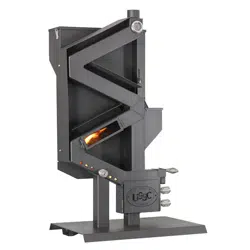Loading ...
Loading ...
Loading ...

8
© 2021 United States Stove Company
SECURING APPLIANCE TO THE FLOOR
Securely fasten this stove to the floor by screwing 1/4”
lag bolts up through the floor into the leg leveling holes.
WARNING! DO NOT INSTALL IN SLEEPING ROOM.
CAUTION! THE STRUCTURAL INTEGRITY OF THE
MOBILE HOME FLOOR, WALL, AND CEILING/
ROOF MUST BE MAINTAINED. MAINTAIN AN
EFFECTIVE VAPOR BARRIER BY SEALING WITH
SILICONE WHERE THE CHIMNEY OR OTHER
COMPONENTS PENETRATE TO THE EXTERIOR OF
THE STRUCTURE.
WHEN INSTALLED IN A MOBILE HOME, THE STOVE
MUST BE GROUNDED DIRECTLY TO THE STEEL
CHASSIS AND BOLTED TO THE FLOOR.
In addition to the previously detailed installation
requirements, mobile home installations must meet the
following requirements:
• All installations must meet local codes.
• Install option 1: Use 3”-4” listed L vent pellet pipe -or-
Install option 2: Use 4”, 5”, or 6” class A 103 HT chimney
system. Note: Do not mix use of chimney systems
during installation. Use 1 system type throughout the
installation.
• Use a minimum of 24 gauge, 4” or larger connector pipe
with the class A 103 HT chimney system (install option
2).
• This is a wood stove that burns wood pellet fuel. This
means natural draft is running the stove. It must be
treated as a wood stove with the pipe installation being
as vertical as possible to obtain maximum upward
draft.
• Horizontal runs and elbows are discouraged.
• Do not install a manual flue damper in the exhaust vent.
Install vent at clearances specified by the vent
manufacturer. The chimney connector shall not pass
through an attic or roof space, closet or similar concealed
space, or floor, or ceiling. Where passage through a wall
or partition of combustible construction is desired, the
installation shall conform to CAN/CSA-B365, US-L
vent installation code for solid fuel burning appliances
and equipment. Exhaust vent required for residential
installation or mobile home installation (US only) is a
listed type “PL” venting - 3” or 4” (76 mm or 102 mm)
diameter. If installed into a tightly constructed home,
(Mobile Home) a fresh air opening of at least 2” (150
mm) diameter into the room where the unit is installed
is required.
WARNING:
DO NOT COMPROMISE INSTRUCTIONS FOR
INSTALLATION OR MAKE CHANGES TO
MANUFACTURERS SPECIFICATIONS DURING THE
INSTALLATION OF THIS PRODUCT.
Attach and secure the exhaust venting system to the
product and to each adjoining section. All joints for
connector pipe shall be required to be fastened with
at least three screws. The area where the vent pipe
penetrates to the exterior of the home must be sealed
with silicone or other means to maintain the vapor barrier
between the exterior and the interior of the home. Vent
surfaces can get hot enough to cause burns if touched.
Noncombustible shielding or guards may be required.
IMPORTANCE OF PROPER DRAFT
Draft is the force which moves air from the appliance
up through the chimney. The amount of draft in your
chimney depends on the length of the chimney, local
geography, nearby obstructions and other factors. Too
much draft may cause excessive temperatures in the
appliance. Inadequate draft may cause back pung into
the room and ‘plugging’ of the chimney. Inadequate draft
will cause the appliance to leak smoke into the room
through appliance and chimney connector joints. An
uncontrollable burn or excessive temperature indicates
excessive draft. Take into account the chimney’s location
to ensure it is not too close to neighbors or in a valley
which may cause unhealthy or nuisance conditions.
STOVE PIPE INSTALLATION
This stove has no need for electricity, it operates with
a natural draft. The strength of the draft is determined
by the height of its chimney, and that’s why the chimney
installation is the determining factor on how well this
stove will perform. This stove will operate best with a
straight chimney either 3” diameter or 4” diameter with
8ft to 12ft overall height, although it will operate with
many variance’s of chimney height and configurations,
they will all bring varied results in burn time and fuel
usage. A straight chimney is always the best configuration
for this pellet stove. Do not make changes to the draft
recommendations during the installation of the chimney
or stove. This is a stove that burns pellet fuel, if an adequate
draft is not accomplished this stove will not operate
properly and can potentially cause smoke to come from
the stove. If the draft is compromised, it can drastically
impede the performance of the stove, especially when
using hardwood pellet fuel. Long horizontal chimney runs
will impede the draft and cause poor performance of this
stove.
INSTALLATION
Loading ...
Loading ...
Loading ...
